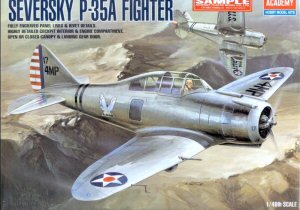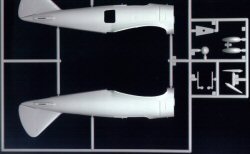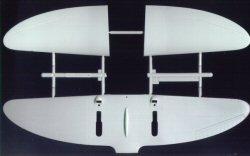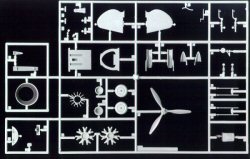
Academy 1/48 Seversky P-35A Kit First Look
By Michael Benolkin
| Date of Review | September 2005 | Manufacturer | Academy |
|---|---|---|---|
| Subject | Seversky P-35A | Scale | 1/48 |
| Kit Number | 2180 | Primary Media | Styrene |
| Pros | Very nicely tooled and detailed kit | Cons | Spartan cockpit |
| Skill Level | Basic | MSRP (USD) | $22.00 |
First Look
 |
 |
 |
 |
 |
The Seversky P-35 and Curtiss P-36 were both designed, built and operated during the mid-1930s. Many of these aircraft were in service during the opening days of World War Two. What is especially interesting is that BOTH of these aircraft were the basis of two of the most famous fighters from WW2.
Alexander de Seversky, a Russian immigrant to the US, formed an aircraft company within four years of his arrival. One of his first US projects, the Seversky P-35 first flew in 1935, and would serve in the peacetime US Army Air Corps as well as being exported as the EP-1 to Sweden. In fact, only 60 of Sweden's 120 ordered EP-1s were delivered, the rest were pulled into US service when the possibility of war loomed on the horizon. Two thirds of the USAAC's P-35/EP-1 fleet were lost during the Japanese attacks on the Philippines in December 1941. In the interim, improvements made to the P-35 led to the P-43 Lancer, and ultimately the P-47 Thunderbolt. The Seversky Aircraft Company had become the Republic Aircraft Company.
Academy released another installment in their 'between the wars' series - the Seversky P-35. Based on the Hobbycraft kit released a number of years ago, this kit features sharp molding and recessed/scribed panel lines. Free of flash, the parts trees in the kit are also free of sink marks and ejector pin marks in visible places. The plastic is molded in light grey with very clear canopies/transparencies.
Like the Hobbycraft kit, this kit is rather spartan in the cockpit detail department, but is laid out such that the scratchbuilder/superdetailer will have a clean palette to work with. Details are limited to seat, seat frame, floor, aft bulkhead, control stick, and instrument panel with rudder pedals. Aftermarket detail sets for the Hobbycraft P-35 will be adaptable to this kit as well.
The P-35 has that huge window on the right side of the fuselage, but lacks any interior detailing to 'see' through the window. Again, a good reference book and some Evergreen plastic strips will solve this problem as well.
The engine detail is simple but effective. While the cooling vanes on the radial engines are not represented, by the time you get some good detail painting done on either engine and install it inside of those tight cowls, you'll never notice the vanes.
The overall fit of the kit is very good. It doesn't look like seam filler will be required if care is taken during assembly. The only potential problem I foresee is the underside wing/fuselage joint, but this will be little more than a touch of cyano gap filler and some sanding/polishing. The plastic that Academy uses in their kits responds well to Tenax, so a little care and patience will render a seamless flying machine.
The P-35 includes markings for a USAAC and a Swedish AF example.
This kit is a good addition to Academy's growing list of aircraft subjects. The molding is nicely done and it will provide a nice kit straight out of the box, or provide the advanced modeler with the basis for a masterpiece. I recommend this kit to modelers of all skill levels.
My sincere thanks to MRC for this review sample!







